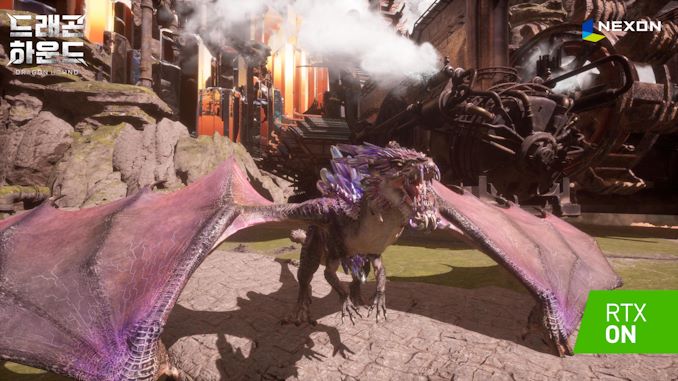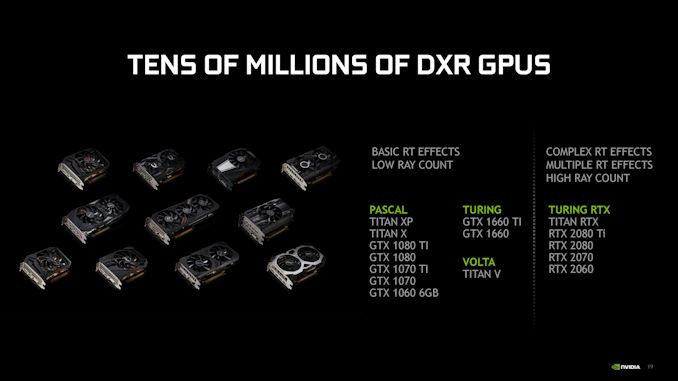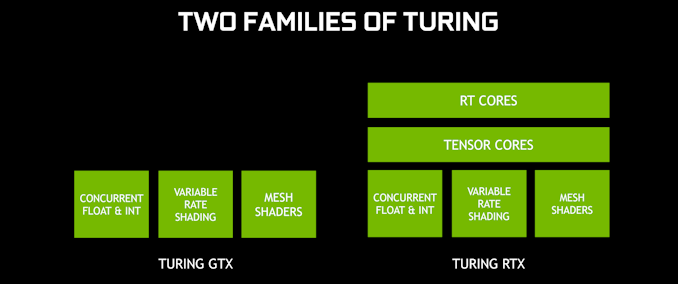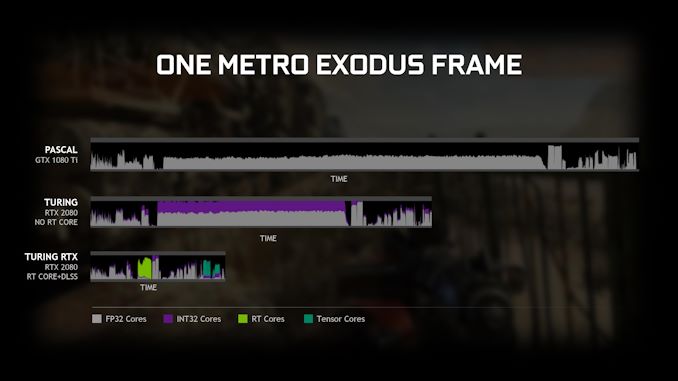NVIDIA To Bring DXR Ray Tracing Support to GeForce 10 & 16 Series In April
by Ian Cutress & Ryan Smith on March 18, 2019 6:40 PM EST
During this week, both GDC (the Game Developers’ Conference) and GTC (the Game Technology Conference) are happing in California, and NVIDIA is out in force. The company's marquee gaming-related announcement today is that, as many have been expecting would happen, NVIDIA is bringing DirectX 12 DXR raytracing support to the company's GeForce 10 series and GeForce 16 series cards.
When Microsoft first announced the DirectX Raytracing API just over a year ago, they set out a plan for essentially two tiers of hardware. The forward-looking plan (and long-term goal) was to get manufacturers to implement hardware features to accelerate raytracing. However in the shorter term, and owing to the fact that the API doesn't say how ray tracing should be implemented, DXR would also allow for software (compute shader) based solutions for GPUs that lack complete hardware acceleration. In fact, Microsoft had been using their own internally-developed fallback layer to allow them to develop the API and test against it internally, but past that they left it up to hardware vendors if they wanted to develop their own mechanisms for supporting DXR on pre-raytracing GPUs.
NVIDIA for their part has decided to go ahead with this, announcing that they will support DXR on many of their GeForce 10 (Pascal) and GeForce 16 (Turing GTX) series video cards. Specifically, the GeForce GTX 1060 6GB and higher, as well as the new GTX 1660 series video cards.
Now, as you might expect, raytracing performance on these cards is going to be much (much) slower than it is on NVIDIA's RTX series cards, all of which have hardware raytracing support via NVIDIA's RTX backend. NVIDIA's official numbers are that the RTX cards are 2-3x faster than the GTX cards, however this is going to be workload-dependent. Ultimately it's the game and the settings used that will determine just how much of an additional workload raytracing will place on a GTX card.
The inclusion of DXR support on these cards is functional – that is to say, its inclusion isn't merely for baseline featureset compatibility, ala FP64 support on these same parts – but it's very much in a lower league in terms of performance. And given just how performance-intensive raytracing is on RTX cards, it remains to be seen just how useful the feature will be on cards lacking the RTX hardware. Scaling down image quality will help to stabilize performance, for example, but then at that point will the image quality gains be worth it?
Under the hood, NVIDIA is implementing support for DXR via compute shaders run on the CUDA cores. In this area the recent GeForce GTX 16 series cards, which are based on the Turing architecture sans RTX hardware, have a small leg up. Turing includes separate INT32 cores (rather than tying them to the FP32 cores), so like other compute shader workloads on these cards, it's possible to pick up some performance by simultaneously executing FP32 and INT32 instructions. It won't make up for the lack of RTX hardware, but it at least gives the recent cards an extra push. Otherwise, Pascal cards will be the slowest in this respect, as their compute shader-based path has the highest overhead of all of these solutions.

This list of cards includes mobile equivalents
One interesting side effect is that because DXR support is handled at the driver level, the addition of DXR support is supposed to be transparent to current DXR-enabled games. That means developers won't need to issue updates to get DXR working on these GTX cards. However it goes without saying that because of the performance differences, they likely will want to anyhow, if only to provide settings suitable for video cards lacking raytracing hardware.
NVIDIA's own guidance is that GTX cards should expect to run low-quality effects. Users/developers will also want to avoid the most costly effects such as global illumination, and stick to "cheaper" effects like material-specfic reflections.
Diving into the numbers a bit more, in one example, NVIDIA showed a representative frame of Metro Exodus using DXR for global illumination. The top graph shows a Pascal GPU, with only FP32 compute, having a long render time in the middle for the effects. The middle bar, showing an RTX 2080 but could equally be a GTX 1660 Ti, shows FP32 and INT32 compute working together during the RT portion of the workload and speeding the process up. The final bar shows the effect of adding RT cores to the mix, and tensor cores at the end.
Ultimately the release of DXR support for NVIDIA's non-RTX cards shouldn't be taken as too surprising – on top of the fact that the API was initially demoed on pre-RTX Volta hardware, NVIDIA was strongly hinting as early as last year that this would happen. So by and large this is NVIDIA fulfilling earlier goals. Still, it will be interesting to see whether DXR actually sees any use on the company's GTX cards, or if the overall performance is simply too slow to bother. The performance hit in current games certainly favors the latter outcome, but it's going to be developers that make or break it in the long run.
Meanwhile, gamers will get to find out for themselves with NVIDIA's DXR-enabled driver release, which is expected to come out next month.
Source: NVIDIA



















38 Comments
View All Comments
JackTheBear - Tuesday, March 19, 2019 - link
That's the best part! You don't have to sign up. You already have it.sonny73n - Wednesday, March 20, 2019 - link
How can a normal person spend hundreds to thousands of dollars for a graphic card so he can just sit on his ass all day to play with it? The cheapest RTX card 2060 is around $400 with tax. Does he work? Does he have to pay bills? What’s about saving? Does he have chores around the house? Does he have any friend beside the virtual ones he games with? Except for rich spoiled brats and drug dealers, of course.I don’t understand how people can invest so much money in a rig just to play stupid boring 3D games. They must be eye candy suckers who has nothing better to do and nothing better to spend their money on. I used to build and troubleshoot systems for gamers. I have tried many 3D games, including some new releases lately such as Metro Exodus, BF5, BF1, CoD4, Assassin Creed etc... If online social interaction functions taken away from these games, they’d be just a bunch of boring craps. They’re so much less meaningful and fun compared to simple 2D games such as Angry Birds, Flappy Bird or Chess games on my low specs phone. But hey, it’s your life. Be useless and stupid is your right after all.
catavalon21 - Wednesday, March 20, 2019 - link
What you or I value for the cost of an entertainment dollar is not necessarily what the next person values. Some people eat out every weekend. Some people go the movies every weekend. Some people play video games every weekend. The cost of a computer, including an expensive video card, for people to whom that's their happy place, isn't necessarily higher over the life of that hardware than what others choose to do. Yes, you have to be able to afford it, and many of us will never have the latest cutting edge hardware in a rig. For those who can, a $3500 USD computer, if it lasts 3 years, is an investment (rig only) of $22 per week. For those who can afford "their happy place" at that price, have a marvelous time. The rest of us will buy a rung (or three) down the hardware tier.Never judge someone else's values.
sonny73n - Wednesday, March 20, 2019 - link
Well, if the “gamers” can be happy with their current hardwares for a while. I live with a hardcore gamer, I know. And he’s my 24 yo son. Don’t get me wrong, he’s a good kid and all. But spending all his free time beside school in front of his PC isn’t exactly the value of one’s life should have. Like I said if you wanna be unproductive member of society, it’s your choice but you would be a loser in my book. I do judge people based on their values and actions. Don’t we all?If you ever step into this world as an NPC for the first time, you would be saying “wow, this is a real 3D world” and you would be thinking how wonderful to interact with others with god given 5 senses. GPU makers try to fool people with their 3D imitations new tech (ray tracing in this case) but the display is physically 2D, pixels alignment and all. Only eye candy suckers would fall for this trick and fork out more money to upgrade. Now back to this topic, I’ll just quote someone else’s. He said it better than I could ever had.
“Giving more customers the opportunity to test RTX features is a solid move, but we don’t expect to see much in the way of playable frame rates. Nor does Nvidia have any reason whatsoever to provide them. The point is to push players into upgrading, not offer acceptable performance on older hardware. This is not to say that Nvidia would take steps to cripple the performance of ray tracing on older GPUs, but they certainly don’t have any reason whatsoever to optimize it.”
Qasar - Thursday, March 21, 2019 - link
sonny73n as catavalon21 said.. to each is own.. while you see some one spending hundreds of dollars on hardware to play games as a waste.. others.. have no issues... thats their choice.. same for those that eat out all the time.. go to the theater to watch a movie, their choice.. again.. to each their own.. myself.. i dont spend hundreds to thousands of dollars for a graphic card, or comp hardware for that matter.. i do spend, what i can afford to, and feel comfortable with... and i have made some good friends playing the games i do, even made some friends that are also local people, that we get together in person quite often.while you consider 3d games to be stupid and boring.. the games you listed.. i consider to be stupid and boring.. and they’re so much less meaningful and fun compared 3d games, again.. to each their own. But hey, it’s your life. Be useless and stupid is your right after all. :-)
Tams80 - Wednesday, March 20, 2019 - link
And you can be ignorant, condescending, rude, arrogant, disdainful, ununderstanding and vain.But hey, that's your right.
webdoctors - Wednesday, March 20, 2019 - link
I don't know how old you are, but pre-1999, any decent home PC would be upwards of $1500, and $400 of that was just for the CRT monitor.Desktop computers last for a looong time, I'm still rocking my Sandbridge CPU based system from 6+ years ago, and it was a cheap upgrade because I sold the prior components when I upgraded to it. Nowadays you only need to keep upgrading the videocard, and its relatively "cheap" compared to the cost of AAA games which are often $30-60/pop.
Look at how many ppl spend $2k+ to get leather seats in their cars, isn't that a huge waste of money? Its all relative. My wife blows way more than $500/month on tons of random garbage, not even including the cosmetics. Some coffee mug of a cat, or her 20th handbag.
sonny73n - Wednesday, March 20, 2019 - link
“NVIDIA is bringing DirectX 12 DXR raytracing support to the company's GeForce 10 series and GeForce 16 series cards.”Does that mean Windows 7 is not supported? Or perhaps that depends on the partially functioned DX12 Microsoft will bring to Windows 7?